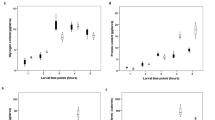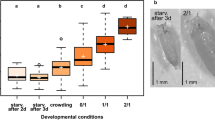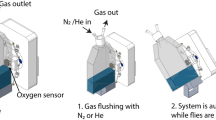Abstract
Recent geological models indicate a marked increase in atmospheric oxygen partial pressure (aPO~2~) to 32 kPa in the Permo-Carboniferous (approx. 300 million years ago), subsequently falling to 13 kPa in the Triassic^1^.These aPO~2~ changes have been hypothesized to cause multiple major evolutionary events^2^ including the appearance and subsequent extinction of giant insects and other taxa^3, 4^. Patterns of increasing tracheal investment in larger insects support this hypothesis^5^, as do observations of positive relationships between aPO~2~ and body size in single- or multi-generational experiments with Drosophila melanogaster and other insects^6^. Large species likely result from many generations of selection for large body size driven by predation, competition or sexual selection^7^. Thus a crucial question is whether aPO~2~ influences the capacity of such selection to increase insect size. We tested that possibility by selecting for large body size in five Drosophila melanogaster populations for 11 generations in hypoxic (10 kPa), normoxic (21 kPa) and hyperoxic (40 kPa) aPO~2~, followed by three generations of normoxia without size selection to test for evolved responses. Average body sizes increased by 15% during 11 generations of size selection in 21 and 40 kPa aPO~2~ flies and even stronger responses were observed for the flies in the largest quartile of body masses. However, flies selected for large size in 10 kPa aPO~2~ had strongly reduced sizes compared to those in higher aPO~2~. Upon return to normoxia, all flies had similar, enlarged sizes relative to the starting populations. These results demonstrated that positive size selection had equivalent genetic effects on all flies independent of aPO~2~, but that hypoxia provided a physical constraint on body size even in a relatively small insect under strong selection for larger mass. Our data support the hypothesis that Triassic hypoxia may have contributed to a reduction in insect size.
Similar content being viewed by others
Article PDF
Author information
Authors and Affiliations
Rights and permissions
About this article
Cite this article
Klok, C., Harrison, J. Atmospheric hypoxia limits selection for large body size in insects. Nat Prec (2008). https://doi.org/10.1038/npre.2008.1831.1
Received:
Accepted:
Published:
DOI: https://doi.org/10.1038/npre.2008.1831.1



